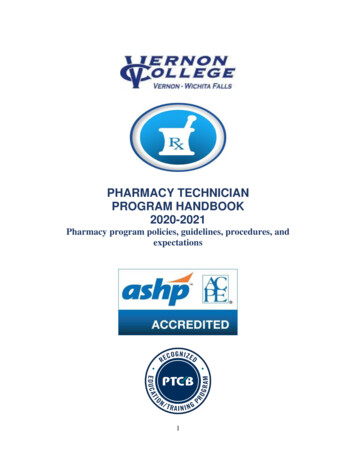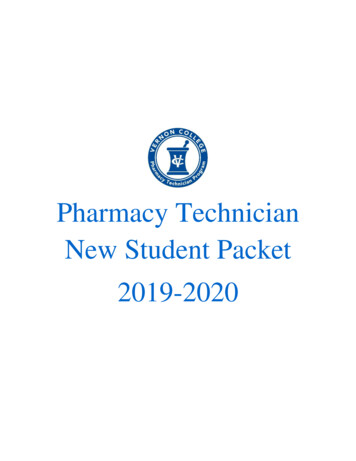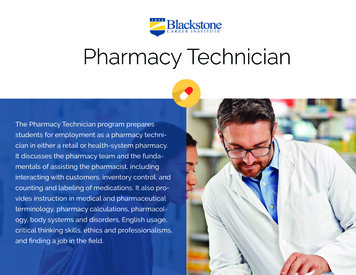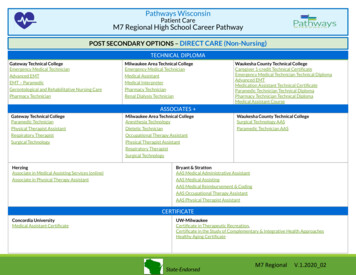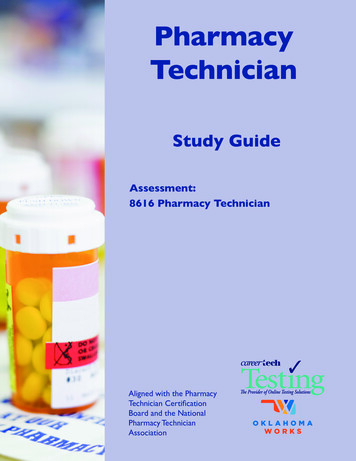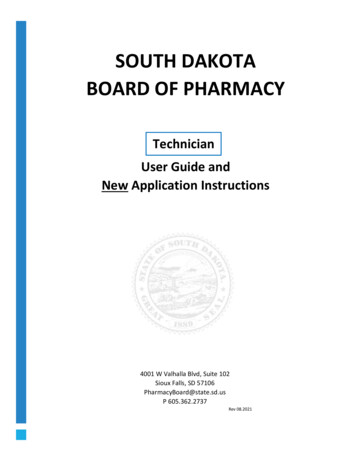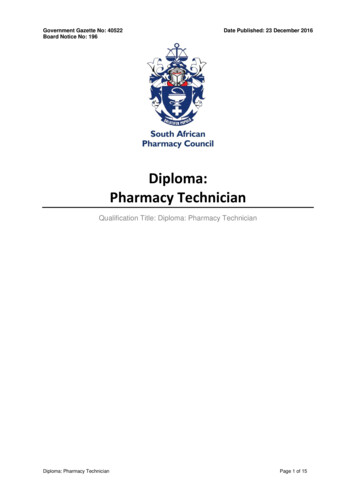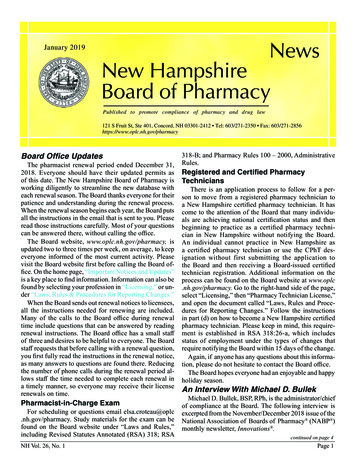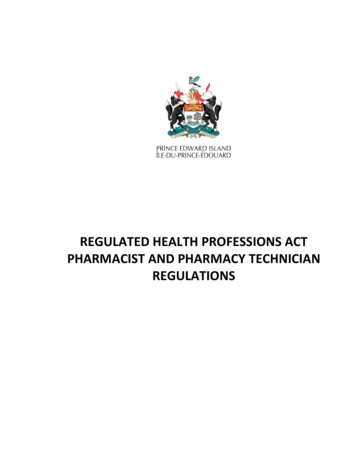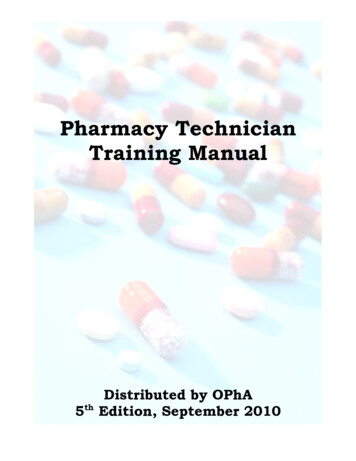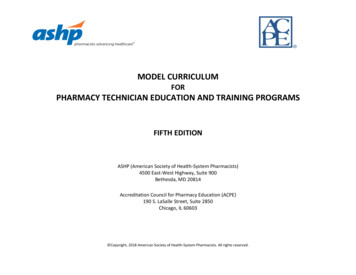
Transcription
MODEL CURRICULUMFORPHARMACY TECHNICIAN EDUCATION AND TRAINING PROGRAMSFIFTH EDITIONASHP (American Society of Health-System Pharmacists)4500 East-West Highway, Suite 900Bethesda, MD 20814Accreditation Council for Pharmacy Education (ACPE)190 S. LaSalle Street, Suite 2850Chicago, IL 60603 Copyright, 2018 American Society of Health-System Pharmacists. All rights reserved.
ACKNOWLEDGEMENTSFor their help in revising the Model Curriculum for Pharmacy Technician Education and Training Programs (Model Curriculum) thanks go to:Pharmacy Technician Advisory BoardASHP / ACPE StaffHope Ballard, CPhTProgram DirectorFortis Institute CookevilleCookeville, TNEric M. Grace, M.S.T., B.A.Director, Standards Development and Training, Accreditation ServicesASHPBethesda, MDCharles E. Daniels, B.S. Pharm., Ph.D., FASHPDirector, Department of PharmacyUniversity of California, San Diego HealthSan Diego, CALisa S. Lifshin, R.Ph.Sr. Director, Pharmacy Technician Program Accreditation & ResidencyServices, Accreditation ServicesASHPBethesda, MDMichael Diamond, M.Sc.PresidentWorld Resources ChicagoEvanston, ILJanet A. Silvester, Pharm.D., M.B.A., FASHPVice President, Accreditation ServicesASHPBethesda, MDBarbara Giacomelli, Pharm.D., M.B.A., FASHPVice President McKesson RxOMcKesson Health SystemsMorristown, NJPeter H. Vlasses, Pharm.D., DSc(Hon), FCCPExecutive DirectorAccreditation Council for Pharmacy EducationChicago, ILJacqueline Hall, RPH, M.B.A.Pharmacy Manager, WalgreensDirector of Pharmacy Services, St. Vincent de Paul CommunityAdjunct Clinical Assistant Professor, Xavier University COPNew Orleans, LAJeffery W. Walden, Ph.D.Associate Executive DirectorAccreditation Council for Pharmacy EducationChicago, ILJanet Kozakiewicz, M.S., Pharm.D., FASHPDirector of Pharmacy ServicesYale New HavenNew Haven, CTBarbara Lacher, B.S., RPhT, CPhTAssistant Program Director & Associate Professor of Pharmacy2
ASHP Contract SurveyorsTechnician ProgramNorth Dakota State College of ScienceFargo, NDW. Renee Acosta, R.Ph., M.S.Clinical Assistant ProfessorDivision of Pharmacy Practice, College of PharmacyThe University of Texas at AustinAustin, TXMichael A. Mone, RPh, J.D., FAPHAV.P. Anti-Diversion & Supply Chain Integrity & Sr. Regulatory CounselHealthcare Supply Chain ServicesCardinal HealthDublin, OHMary B. McHugh, Pharm.D., R.Ph.ProfessorMissoula College-University of MontanaMissoula, MTDoris Jean (Jeannie) McDaniel-Pappas, RPT, CPhTPharmacy Technician Program DirectorPinellas Technical CollegeSt. Petersburg, FLSheri Roumell, B.S., CPhT, RPTGlenrock, WYKathleen S. Pawlicki, B.S.Pharm., M.S., RPh, FASHPVice President and Chief PharmacistBeaumont HealthRoyal Oak, MIMatthew A. Rewald, B.S., CPhTCoordinator, Pharmacy Technician Education & Assistant Professor ofPharmacyMayo ClinicRochester, MN3
INTRODUCTION TO THE FIFTH EDITIONModel Curriculum for Pharmacy Technician Education and Training Programs (Model Curriculum) provides details on how to meet the newASHP/ACPE Accreditation Standards for Pharmacy Technician Education and Training Programs (Standards). This edition of the Model Curriculumreflects changes to the ASHP/ACPE Accreditation Standards for Pharmacy Technician Education and Training Programs that was approved by theASHP Board of Directors in June of 2018. The new set of Key Elements took into consideration the recommendations from the February 2017Pharmacy Technician Stakeholder Consensus Conference, the most recent task analysis or blue print of national technician certificationexaminations, and other current practice trends. The new Standards are intended to be responsive to changes in the pharmacy profession andthe evolving role of pharmacy technicians. The Model Curriculum includes standards and key elements for Entry-Level and Advanced-Level oftechnician education and training, resulting in some significant revisions. Summary of changes to the Standards include: Entry-level and Advanced-level pharmacy technician education and training standards have replaced the previous concept of onelevel of pharmacy technician education and training.Programs can choose to offer an Entry-level, an Advanced-level, or a combination of Entry-level and Advanced-level pharmacytechnician education and training programs.All students need to complete an Entry-level program to pursue Advanced-level education and training or can complete a programthat prepares for both levels as a continuous program.Standards have been reorganized into three sections with the competency expectations being moved to the forefront.The Standards have been restructured into 15 standards with key elements of each standard that need to be met.For some of the Standards, the key elements are broken into Entry-level and Advanced-level.These Standards no longer include the words “must” and “should”. The Standards are declarative statements of expectation.Minimum hour requirements have been edited to reflect education and training needs for Entry-level and Advanced-levelcompetencies.More emphasis on collaborative behaviors and workflow with pharmacist and health care staff.The Model Curriculum includes the required Key Elements for each of the standards and corresponding competencies, as well as examples oflearning activities for each portion of the program, including didactic, simulated (lab), and experiential program components as described in theoverview below. The Model Curriculum is intended to guide new programs that have recently begun, as well as existing programs that arereviewing their curriculum to meet the new Standards.The new Model Curriculum may be used in an interactive manner, as a template to which programs may add notes and/or additional activities tothe columns that describe the different program component learning modalities. Simply use a different font and/or color to add your ownactivities to describe how your program is teaching the Key Elements to meet a particular standard. The template can be used as evidenceduring an accreditation survey.4
OVERVIEWThe format of the Model Curriculum includes four columns for each Key Element, described in the chart below. A Key Element is defined asbroad area of capability that students need to be able to achieve to meet the particular standard. The Learning Modality examples provided foreach Key Element are suggestions only, as other options and additional content/activities may be utilized at the discretion of each program.Always have students act in accordance with relevant state laws and regulations at the experiential site, with oversight of the Preceptorand/or Pharmacist where appropriate or necessary.Column 1:Standard Key ElementColumn 2:Didactic Content and TopicsColumn 3:Sample Simulation ActivitiesColumn 4:Sample Experiential ActivitiesKey Elements are descriptionsof what learners must be ableto do, to achieve theassociated aspects andcompetencies to meet theStandard.Didactic content and topicexamples to teach learners, sothey may obtain the knowledgeand ability to meet the KeyElements.Sample activities for thesimulated (lab) portion of theprogram that teach learners, sothey may obtain the knowledgeand ability to meet the KeyElements.Sample activities for theexperiential portion of theprogram that teach learners, sothey may obtain the knowledgeand ability to meet the KeyElements.The Model Curriculum Key Elements are categorized into the following areas.STANDARD CATEGORIES:1. Personal/Interpersonal Knowledge and Skills2. Foundational Professional Knowledge and Skills3. Processing and Handling of Medications and Medication Orders4. Patient Care, Quality and Safety Knowledge and Skills5. Regulatory and Compliance Knowledge and Skills6. Authority and Responsibility provided to Program Director7. Strategic Plan8. Advisory Committee9. Curricular Length10. Curricular Composition and Delivery11. Student Recruitment, Acceptance, Enrollment, and Representation12. Faculty/Instructors13. Documentation14. Assessment of Competency Expectations15. Assessments of Structure and ProcessThe Key Elements are listed by Standard Categories below as they pertain to the Model Curriculum (Standards 1-5).5
Standard 1: Personal/Interpersonal Knowledge and SkillsENTRY-LEVEL1.1Demonstrate ethical conduct.1.2Present an image appropriate for the profession of pharmacy in appearance and behavior.1.3Demonstrate active and engaged listening skills.1.4Communicate clearly and effectively, both verbally and in writing.1.5Demonstrate a respectful and professional attitude when interacting with diverse patient populations, colleagues, and professionals.1.6Apply self-management skills, including time, stress, and change management.1.7Apply interpersonal skills, including negotiation skills, conflict resolution, customer service, and teamwork.1.8Demonstrate problem solving skills.ADVANCED-LEVEL1.9Demonstrate capability to manage or supervise pharmacy technicians in matters such as conflict resolution, teamwork, and customerservice.1.10 Apply critical thinking skills, creativity, and innovation.1.11 Apply supervisory skills related to human resource policies and procedures.1.12 Demonstrate the ability to effectively and professionally communicate with other healthcare professionals, payors and otherindividuals necessary to serve the needs of patients and practice.Standard 2: Foundational Professional Knowledge and SkillsENTRY-LEVEL2.1Explain the importance of maintaining competency through continuing education and continuing professional development.2.2Demonstrate ability to maintain confidentiality of patient information, and understand applicable state and federal laws.2.3Describe the pharmacy technician’s role, pharmacist’s role, and other occupations in the healthcare environment.2.4Describe wellness promotion and disease prevention concepts.2.5Demonstrate basic knowledge of anatomy, physiology and pharmacology, and medical terminology relevant to the pharmacytechnician’s role.2.6Perform mathematical calculations essential to the duties of pharmacy technicians in a variety of settings.2.7Explain the pharmacy technician's role in the medication-use process.2.8Practice and adhere to effective infection control procedures.ADVANCED-LEVEL2.9Describe investigational drug process, medications being used in off-label indications, and emerging drug therapies.2.10 Describe further knowledge and skills required for achieving advanced competencies.2.11 Support wellness promotion and disease prevention programs.Standard 3: Processing and Handling of Medications and Medication OrdersENTRY-LEVEL3.1Assist pharmacists in collecting, organizing, and recording demographic and clinical information for the Pharmacists’ Patient CareProcess.3.2Receive, process, and prepare prescriptions/medication orders for completeness, accuracy, and authenticity to ensure safety.6
3.3Assist pharmacists in the identification of patients who desire/require counseling to optimize the use of medications, equipment, anddevices.3.4Prepare patient-specific medications for distribution.3.5Prepare non-patient-specific medications for distribution.3.6Assist pharmacists in preparing, storing, and distributing medication products including those requiring special handling and documentation.3.7Assist pharmacists in the monitoring of medication therapy.3.8Maintain pharmacy facilities and equipment.3.9Use information from Safety Data Sheets (SDS), National Institute of Occupational Safety and Health (NIOSH) Hazardous Drug List,and the United States Pharmacopeia (USP) to identify, handle, dispense, and safely dispose of hazardous medications and materials.3.10 Describe Food and Drug Administration product tracking, tracing and handling requirements.3.11 Apply quality assurance practices to pharmaceuticals, durable and non-durable medical equipment, devices, and supplies.3.12 Explain procedures and communication channels to use in the event of a product recall or shortage, a medication error, oridentification of another problem.3.13 Use current technology to ensure the safety and accuracy of medication dispensing.3.14 Collect payment for medications, pharmacy services, and devices.3.15 Describe basic concepts related to preparation for sterile and non-sterile compounding.3.16 Prepare simple non-sterile medications per applicable USP chapters (e.g., reconstitution, basic ointments and creams).3.17 Assist pharmacists in preparing medications requiring compounding of non-sterile products.3.18 Explain accepted procedures in purchasing pharmaceuticals, devices, and supplies.3.19 Explain accepted procedures in inventory control of medications, equipment, and devices.3.20 Explain accepted procedures utilized in identifying and disposing of expired medications.3.21 Explain accepted procedures in delivery and documentation of immunizations.3.22 Prepare, store, and deliver medication products requiring special handling and documentation.ADVANCED-LEVEL3.23 Prepare compounded sterile preparations per applicable, current USP Chapters.3.24 Prepare medications requiring moderate and high level non-sterile compounding as defined by USP (e.g., suppositories, tablets,complex creams).3.25 Prepare or simulate chemotherapy/hazardous drug preparations per applicable, current USP Chapters.3.26 Initiate, verify, and manage the adjudication of billing for complex and/or specialized pharmacy services and goods.3.27 Apply accepted procedures in purchasing pharmaceuticals, devices, and supplies.3.28 Apply accepted procedures in inventory control of medications, equipment, and devices.3.29 Process, handle, and demonstrate administration techniques and document administration of immunizations and other injectablemedications.3.30 Apply the appropriate medication use process to investigational drugs, medications being used in off-label indications, and emergingdrug therapies as required.3.31 Manage drug product inventory stored in equipment or devices used to ensure the safety and accuracy of medication dispensing.Standard 4: Patient Care, Quality and Safety Knowledge and SkillsENTRY-LEVEL4.1Explain the Pharmacists’ Patient Care Process and describe the role of the pharmacy technician in the patient care process.4.2Apply patient- and medication-safety practices in aspects of the pharmacy technician's roles.7
4.3Explain how pharmacy technicians assist pharmacists in responding to emergent patient situations, safely and legally.4.4Explain basic safety and emergency preparedness procedures applicable to pharmacy services.4.5Assist pharmacist in the medication reconciliation process.4.6Explain point of care testing.4.7Explain pharmacist and pharmacy technician roles in medication management services.4.8Describe best practices regarding quality assurance measures according to leading quality organizations.ADVANCED-LEVEL4.9Verify measurements, preparation, and/or packaging of medications produced by other healthcare professionals.4.10 Perform point-of-care testing to assist pharmacist in assessing patient's clinical status.4.11 Participate in the operations of medication management services.4.12 Participate in technical and operational activities to support the Pharmacists’ Patient Care Process as assigned.4.13 Obtain certification as a Basic Life Support Healthcare Provider.Standard 5: Regulatory and Compliance Knowledge and SkillsENTRY-LEVEL5.1Describe and apply state and federal laws pertaining to processing, handling and dispensing of medications including controlledsubstances.5.2Describe state and federal laws and regulations pertaining to pharmacy technicians.5.3Explain that differences exist between states regarding state regulations, pertaining to pharmacy technicians, and the processing,handling and dispensing of medications.5.4Describe the process and responsibilities required to obtain and maintain registration and/or licensure to work as a pharmacytechnician.5.5Describe pharmacy compliance with professional standards and relevant legal, regulatory, formulary, contractual, and safetyrequirements.5.6Describe Occupational Safety and Health Administration (OSHA), National Institute of Occupational Safety and Health (NIOSH), andUnited States Pharmacopeia (USP) requirements for prevention and treatment of exposure to hazardous substances (e.g., riskassessment, personal protective equipment, eyewash, spill kit).5.7Describe OSHA requirements for prevention and response to blood-borne pathogen exposure (e.g., accidental needle stick, postexposure prophylaxis).5.8Describe OSHA Hazard Communication Standard (i.e., “Employee Right to Know”).ADVANCED-LEVEL5.9Participate in pharmacy compliance with professional standards and relevant legal, regulatory, formulary, contractual, and safetyrequirements.5.10 Describe major trends, issues, goals, and initiatives taking place in the pharmacy profession.8
MODEL CURRICULUMfor Pharmacy Technician Education and Training ProgramsSTANDARD 1: Personal/Interpersonal Knowledge and SkillsENTRY-LEVELKEY ELEMENT1.1 Demonstrateethical ine/Reviewmaterial regarding ethical conduct(e.g., “ethics” definition).LEARNING MODALITIESSimulated (Lab)Examples:Combine ethically challengingsituations with other lab activitiesthat require students to applyethical judgment and decisions.Describe sample ethical situationsand ask students to describe andjustify ethical responses.ENTRY-LEVELKEY ELEMENT1.2 Present animage appropriatefor the profession ofpharmacy inappearance /Define/Reviewhow pharmacy technicians presentan image appropriate for theprofession, in appearance andbehavior, including the followingtopics:o appropriate attireo appropriate hygieneo professional attitude anddemeanoro behavior during challengingsituationsLEARNING MODALITIESSimulated (Lab)Examples:Have students dress the way theywould on a job and giveconstructive feedback as needed.Role-play challenging situations andhow to professionally handle them.Show or describe variousappearances of technicians and askif they are acceptable, why or whynot and how unacceptableappearances can be improved.Have students describe how theywould respond professionally inchallenging situations.Give examples of professional and9ExperientialExamples:Have students demonstrate ethicalresponses when called for.Ask students to describe ethicalchallenges they encountered andhow they responded to them.ExperientialExamples:Exhibit appropriate dress, hygieneand behavior at the experientialsite.Ask students to describe challengingsituations they encountered. Havethem describe how they handledthe situation and discuss ways itmight have been handled moreeffectively, if needed.
informal communications and askstudents which are appropriate.Have them translate informalcommunications into a professionalcommunication style.ENTRY-LEVELKEY ELEMENT1.3 Demonstrateactive and engagedlistening skills.ENTRY-LEVELKEY ELEMENT1.4 Communicateclearly andeffectively, bothverbally and efine/Reviewhow pharmacy techniciansdemonstrate active and engagedlistening skills (e.g., body efine/Reviewhow pharmacy technicianscommunicate clearly andeffectively, both verbally and inwriting (e.g., how to pronouncetechnical terms accurately).LEARNING MODALITIESSimulated (Lab)Examples:Simulate common spokencommunications withpatients/customers, role-playingtypical interpersonal situations withdistracting elements in theenvironment.LEARNING MODALITIESSimulated (Lab)Examples:Simulate common spoken andwritten communications.Instructor correctly and incorrectlypronounces terms. Have studentsidentify when terms are correctlypronounced. If incorrect, ask themto say them correctly.Have students give common verbaland written communications. Haveother students and/or instructorgive feedback about if they clearlyunderstood them and/or how theycould be improved.ENTRY-LEVELLEARNING MODALITIES10ExperientialExample:Observe students to ensure they areengaged and listening. Givefeedback to students on how welltheir listening skills come across topatients and team members.ExperientialExamples:Give feedback if verbalcommunications are unclear andhow they can be improved.Review selected writtencommunications with students andprovide constructive feedback.
KEY ELEMENT1.5 Demonstrate arespectful andprofessionalattitude wheninteracting withdiverse patientpopulations,colleagues, andprofessionals.ENTRY-LEVELKEY ELEMENT1.6 Apply selfmanagement skills,including time,stress, and plain/Define/Review:how pharmacy techniciansdemonstrate a respectful andprofessional attitude wheninteracting with diverse patientpopulations, colleagues, andprofessionals, including thefollowing topics:o respectful vs. disrespectfulactionso special communication strategieso cultural competenceSimulated (Lab)Examples:Group discussion about possiblechallenges with diverse populationsand how to respond.Discuss relevant situations and howcommunication could be adapted tobe effective.LEARNING MODALITIESSimulated e/Review: Ask students to perform tasks in amanagement skills, including time,predetermined amount of time.stress, and change managementrelated to the pharmacy technicianGive a fictional but typical list ofrole and topics, including:tasks to be completed in a specifiedamount of time and ask students too STAT vs. PRNprioritize and schedule the list.o prioritizing taskso sources of stressDiscuss how well the priorities wereo ways to manage stressselected and how realistic theo principles of changeschedule is.managementDidacticInvite a panel of experiencedpharmacy technicians to come anddiscuss sources of stress on theirjob, how they deal with it andanswer questions from students.ENTRY-LEVELLEARNING MODALITIES11ExperientialExamples:Demonstrate a respectful attitudewhen interacting with diversepatient populations at theexperiential site.Give feedback to students abouthow well they communicate respectand care, verbally and non-verbally,to patients.ExperientialExamples:Ask students to discuss issues ofscheduling and prioritizing asneeded.Have students describe stressfulsituations they encounter at theexperiential site, how they dealtwith them and discuss otherstrategies that could also beapplied.Apply change management skills asneeded at the experiential site.
KEY ELEMENT1.7 Applyinterpersonal skills,includingnegotiation skills,conflict resolution,customer service,and fine/Review:interpersonal skills related to thepharmacy technician role andtopics, including effective skills inthe following areas:o communicationo teamworko conflict resolutiono negotiationo customer serviceHave a class discussion about thecharacteristics of effective workingrelationships. Have students giveexamples of working relationshipsthat have worked well or not andwhat made them that way.ENTRY-LEVELKEY ELEMENT1.8 DemonstrateDidacticproblem solvingskills.Simulated (Lab)ExperientialExamples:Role-play typical interpersonalsituations that may be challenging,such as an uncooperative ordisrespectful member of the healthcare team that the technician mustinteract with in a professionalmanner.Examples:Ask students to describe somechallenging situations requiringeffective interpersonal skills andthat they encountered at theexperiential site. Discuss how theyhandled them and other strategiesthat might have been used.Give students scenarios describingtypes of interactions that occur inthe work of the pharmacytechnician. Ask them whatinterpersonal skills are required tohandle them effectively and whatthey would do in those situations.Handle conflicts effectively at theexperiential site.Describe sample conflict situationsand ask students to discuss howthey would handle them to resolvethe conflict.LEARNING MODALITIESSimulated (Lab)Examples:Simulate/Role-play typical situationsin the pharmacy, where thepharmacy is short on staff and havestudents problem solve foroperational solutions.ExperientialExamples:Have students working with otherpharmacy technicians in the areawho don’t know the skillsappropriately, and how the studentreacts/handles the situation.Observe students to ensure they areresponding appropriately.ADVANCED-LEVELKEY ELEMENTDidacticLEARNING MODALITIESSimulated (Lab)12Experiential
1.9 Demonstratecapability tomanage orsupervise pharmacytechnicians inmatters such asconflict eviewmaterial regarding common tasksand situations where pharmacytechnicians may encounter conflictsand/or customer service issues;where teamwork, communicationskills, and conflict resolutions skillswill be necessary to overcome anissue(s) and/or resolve a conflict(s).teamwork, andExample:Simulate/Role-play typical situationswhere a team must become moreefficient and fill at a faster rate.Have students lead change in howthe pharmacy could be set up. Usethis as an opportunity to resolvedifferences of opinion on howthings should be set up. Teachleadership from both the “leader”side and “good team player” side.customer service.Simulate/Role-play typical situationswhere a staff member is notperforming their assigned task andhave the students indicate how theywould handle the situation.ADVANCED-LEVELKEY ELEMENT1.10 Apply criticalLEARNING MODALITIESSimulated (Lab)Examples:Present a simulated problemrequiring the student to applycritical thinking skills to solve.thinking skills,creativity, andinnovation.ADVANCED-LEVELKEY ne/Reviewmaterial regarding common tasksand situations pharmacy techniciansencounter in the pharmacy thatrequire critical thinking skills,problem solving, creativity andinnovation to solve and/orcomplete.DidacticPresent a simulated problem andask students to use creativity andinnovative thinking to solve theproblem.Example:Have students work with pharmacytechnician supervisor to observeand learn techniques used forconflict resolution, customerservice, resolving issues, etc.ExperientialExamples:Ask students to discuss how criticalthinking skills were applied toproblems encountered at theexperiential site.Ask students to discuss howcreativity and innovation were, orcould be, applied to problemsencountered at the experientialSimulate/Role-play typical situations site.where a customer is at the counterwith patient when order is notfilled/ready.LEARNING MODALITIESSimulated (Lab)13Experiential
1.11 Applysupervisory skillsrelated to humanresource ewinformation regarding HumanResource management and policiesat the organization.and procedures.ADVANCED-LEVELKEY ELEMENT1.12 DemonstrateDidacticthe ability toeffectively andprofessionallycommunicate withother healthcareExample:Simulate/Role-play typical situationswhere a staff member is late orneeds to be reprimanded and needsto counsel a staff member that theysupervise.Examples:Student work with supervisor tolearn site specific policies andprocedures for human resourcesrelated issues.LEARNING MODALITIESSimulated lay typical situations Have students work with nurses andwhere students interact with othercustomers at the experiential site.healthcare staff (e.g., nurses).Observe students to ensure they areresponding appropriately to otherhealthcare professionals. Explainappropriate interactions if needed.professionals,payors and otherindividualsnecessary to servethe needs ofpatients andpractice.STANDARD 2: Foundational Professional Knowledge and SkillsENTRY-LEVELKEY ELEMENTDidacticLEARNING MODALITIESSimulated (Lab)14Experiential
2.1 Explain theimportance ofmaintainingcompetencythrough continuingeducation Y ELEMENT2.2 Demonstrateability to maintainconfidentiality ofpatient information,and viewcontinuing education andcontinuing professionaldevelopment to maintain and buildcompetencies related to thepharmacy technician role andtopics, including:o resources for staying currento local/regional meetings andeventso online opportunities /Define/Reviewmaterial regarding legal and ethicalguidelines for safeguarding theconfidentiality of patientinformation.Examples:Ask students to discuss ways theyplan to continue their learning aftercompleting the pharmacy techniciantraining program.Ask students to share any past orcurrent experiences with anyactivities discussed in the contentcovered.LEARNING MODALITIESSimulated (Lab)Example:Simulate common patientconfidentiality situations.Examples:Share with students activities thatdemonstrate commitment toexcellence in the pharmacyprofession, continuing education,and training. Ask students to discusswhich seem most appropriate forthem and which they are mostinterested in pursuing.ExperientialExample:Observe legal and ethical guidelinesfor safeguarding the confidentialityof patient information at theexperiential site.applicable state andfederal laws.ENTRY-LEVELKEY ELEMENT2.3 Describe thepharmacytechnician’s role,pharmacist’s role,and /ReviewThe pharmacy technician’s role,pharmacist’s role, and otheroccupations in the healthcareenvironment/delivery system,including non-traditional roles ofLEARNING MODALITIESSimulated (Lab)15Experiential
occupations in thepharmacy technicians.healthcareenvironment.ENTRY-LEVELKEY ELEMENT2.4 Describewellness promotionand diseasepreventionconcepts.LEARNING MODALITIESSimulated (Lab)Examples:Have students help others fill outforms necessary for n/Define/Reviewwellness promotion practices anddisease prevention concepts, suchHave students demonstrate use ofas use of health screenings; healthpractices
Always have students act in accordance with relevant state laws and regulations at the experiential site, with oversight of the Preceptor . teamwork, and customer service. 1.10: Apply critical thinking skills, creativity, and innovation. . 3.17: Assist pharmacists in preparing medications requiring compounding of non-sterile products.
